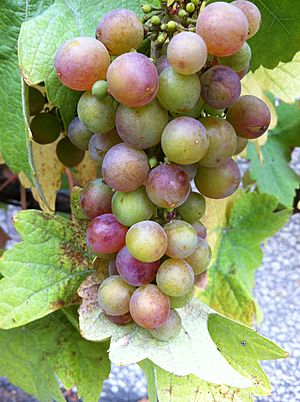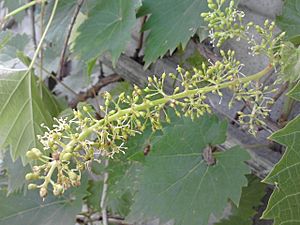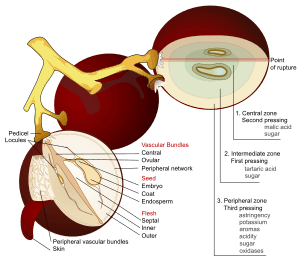Millerandage facts for kids
Millerandage is a problem that can happen to grape bunches. It's also called shot berries, hens and chicks, or pumpkins and peas. When a grape bunch has millerandage, some berries are much smaller than others. They also ripen at different times.
The main reason for millerandage is often cold, rainy, or bad weather. This usually happens when the grapevines are in their flowering stage. Other things can also cause it, like not enough boron (a mineral) or certain plant diseases.
Millerandage always means fewer grapes are harvested. But how it affects the wine quality can be different. For some grapes, like Sangiovese, Zinfandel, and Gewürztraminer, it can be bad. The small, unripe grapes can make the wine taste "green" or unripe. But for other grapes, like Pinot noir or a type of Chardonnay, it can actually make the wine better! This is because the smaller berries mean there's more skin compared to juice, which can add more flavor and color to the wine.
Why Millerandage Happens
Millerandage happens when grape flowers aren't fertilized well. This most often occurs because of bad weather. But it can also be due to a lack of important nutrients, like the mineral boron. Boron helps the vine grow and move sugars. Plant viruses can also play a part.
How Grapes Reproduce
Grapevines usually start to flower about eight weeks after their buds open. This happens when the average daily temperature is around 20 °C (68 °F). Flowers usually open first at the bottom of the flower cluster and then move up. The top parts of the vine flower first. The whole flowering process takes about 7 to 10 days.
For the best flowering, the weather should be warm, sunny, and dry. Some grape types, like Zinfandel and Merlot, flower at different times. This makes them more likely to get millerandage if the weather turns bad. Some farmers use special treatments to help all the flowers open at the same time.
After flowering, the grape flowers are pollinated and fertilized. This takes about 2 to 3 days. Cold weather can cause problems here too. If temperatures drop below 10 °C (50 °F), it can harm the tiny parts of the flower that need to be fertilized. Grapevines are hermaphroditic, meaning each flower has both male and female parts. They usually fertilize themselves. So, wind or insects don't usually affect how well they are pollinated.
Rain can also cause issues. It can wash pollen away from the flower or make the pollen swell up and burst. This stops the pollen from reaching the parts it needs to fertilize.
Even in perfect conditions, only about 20-30% of grape flowers become mature fruits with seeds. If even fewer berries grow, it's called coulure. For the berries that do grow, the number of seeds (or if they have any at all) affects their size. Millerandage happens most often when grapes are partly fertilized and don't grow any seeds. This leaves small, sometimes unripe, berries mixed in with larger, ripe ones.
How Millerandage Affects Wine
Millerandage always means a smaller grape harvest, which costs farmers money. But it doesn't always make the wine worse. In some places, like Australia, California, and New Zealand, some winemakers actually see millerandage as a good thing for a vintage (a year's wine). This is because the smaller berries can lead to more concentrated flavors in the wine. Some farmers even use special sprays to encourage millerandage!
However, the small, seedless berries might never ripen fully. They can stay hard and green, with a high acid level. Some farmers might remove these bunches by hand before harvest. This is called green harvesting. Or they might wait longer to harvest the whole crop. This helps the other grapes get extra ripe to balance out the sour, "green" taste of the small berries. Other farmers remove the small grapes after harvest, when they are sorting the grapes.




